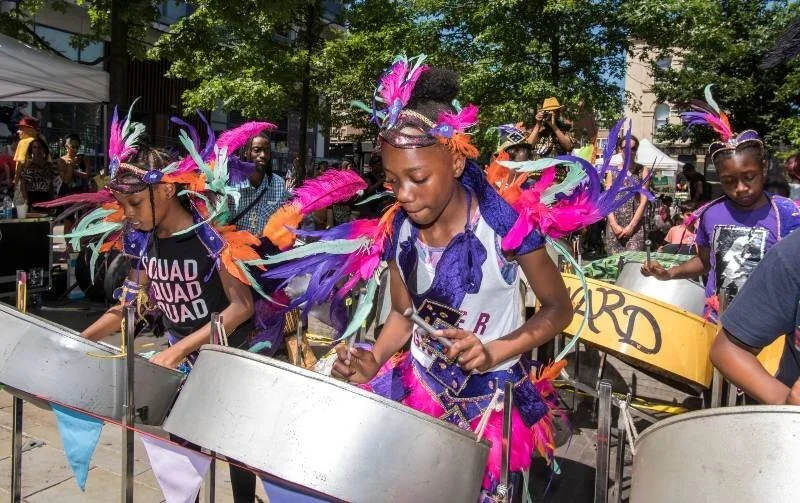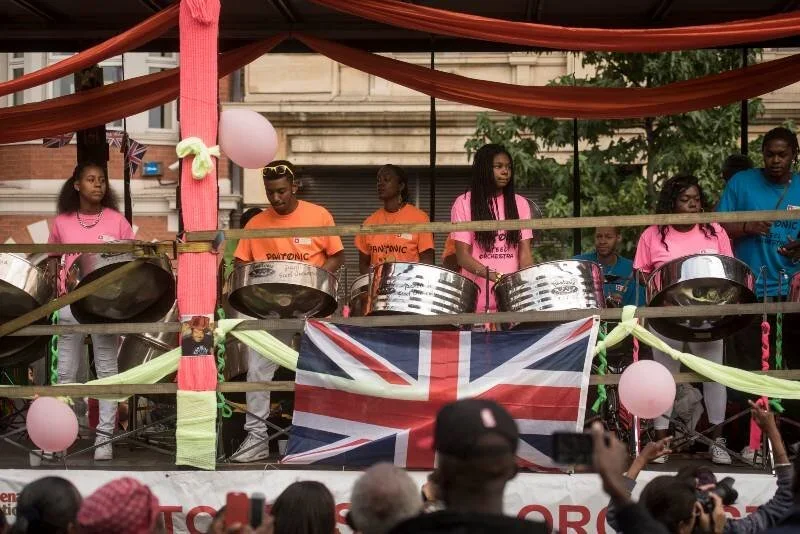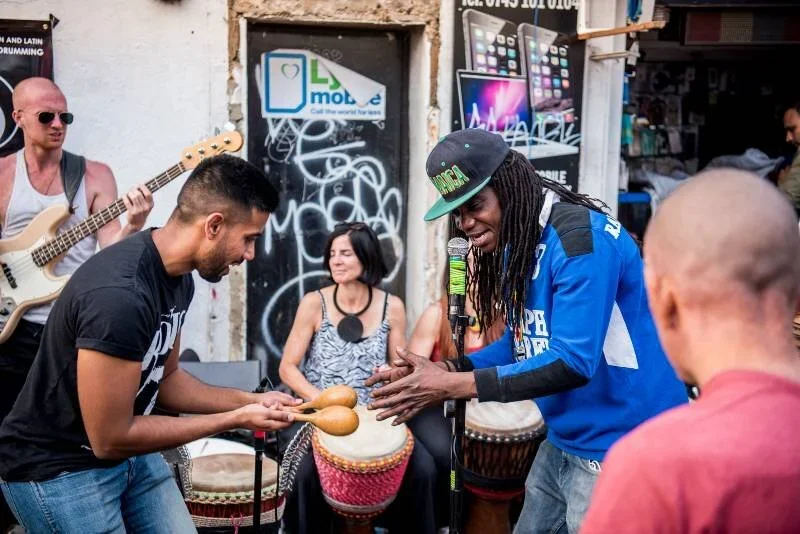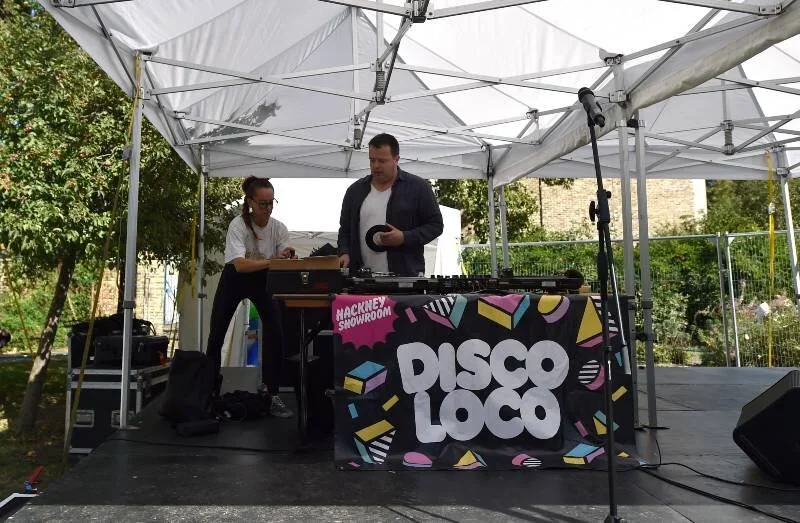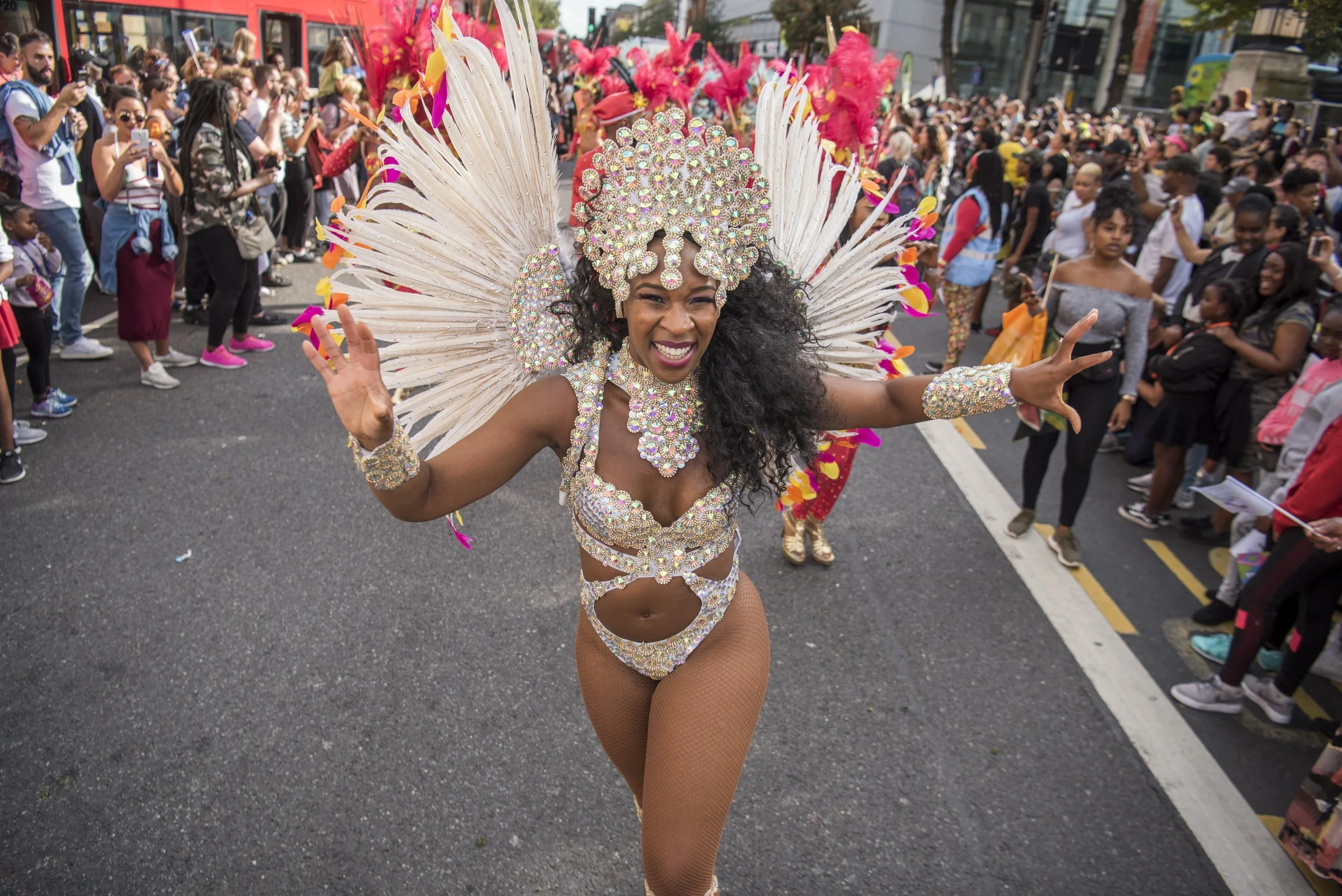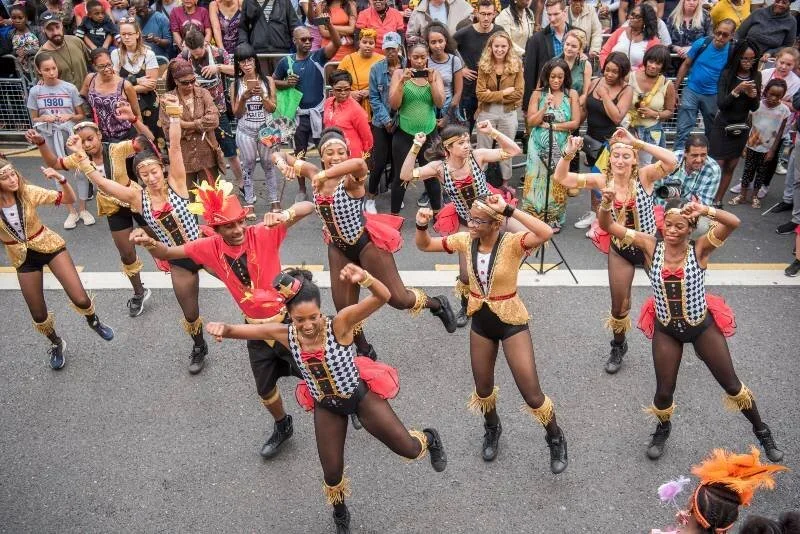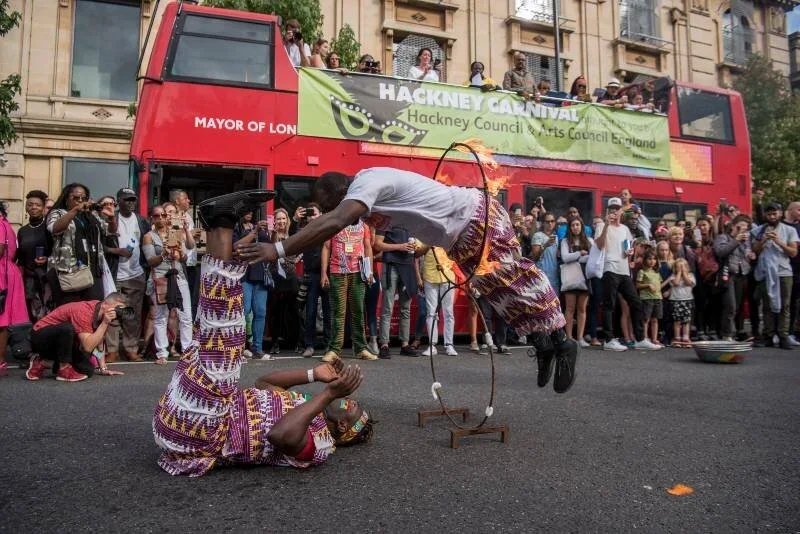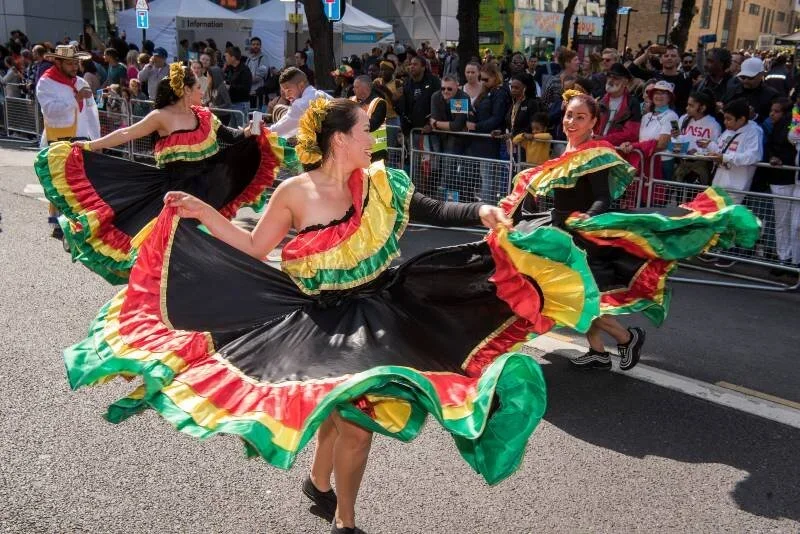The music and dance of Hackney Carnival
Hackney carnival has an abundance of music from all over the world. It features static sound systems by local sound system operators, DJs playing music on floats, stages with live bands and live drumming in the procession.
Local school children and Pan Vibrations at Hackney Carnival 2018
Soca on the move
Music is an essential part of carnival, it underpins the ideology of freedom and getting messages across of resistance at the same time as showcasing different voices in the parade.
Soca Music is a musical style from Trinidad and considered an offshoot from calypso with influences from Soul music developed in the 1970’s by Lord Shorty. The result is an energetic musical hybrid developed as a musical genre.
Soca is a fusion between SOul and CAlypso music. It has absorbed influences from different cultures across the Caribbean islands such as Chutney Soca, Funk, Zouk, Latin, Cadence and traditional West African rhythms.
Hackney groups who specialise in Soca music such as Soca Massive and Soca Saga Boys perform all year round in various events.
Soca Massive Sound System debuted in 1985 and have provided sound systems on the road at Hackney Carnival for the last fourteen years. Michael Olton remembers;
I started as a DJ and our sound system played for many other bands with amplified systems on big 40 foot floats. We’ve won best band on the road no less than eight times. Soca Massive plays at the Trinidad and Tobago Carnival with resident bands and in turn they join us in London. Of course, we play Soca but we also play other music to entertain and please crowds. The younger DJs love mixing reggae, house, grime, raga, soul revival in with the soca. My favourite soca artist is Marshall Montana. I’ve known him since he was a young boy. He likes the old school but younger DJs are doing a good job of keeping Soca alive too.
Soca Saga Boys started as a sound system based in Hackney and took it to another level with louder sound systems as a Black owned organisation spreading the message of unity. Rena Kydd Williams (R Consultancy with Soca Saga Boys) says:
We provide a platform for the Caribbean and African Diaspora culture. The sound system is important to carnival. There are key principles of playing mas. It has to have amplified sound – like the loud drumming in the past that sent messages summoning up strength, unifying people and the sharing of a culture that the enslavers didn’t want expressed. There should be no limit on sound – this is the case in Caribbean carnival. The truck and the big PA is essential. it underpins the ideology of freedom and getting your message across.
We take the message of soca across the world and harness the talents of the people who understand how music moves people and the types of BPM (Beats Per Minute) that different types of Soca have. We know the importance of when to select the right BPM tracks for various parts of “The Road”.
Members of the group Pantonic
Live bands on the road: steel pan
Hackney features steel pan bands in the procession such as visiting group from Notting Hill, UFO Steel band, and Hackney’s very own Pantonic Steel Orchestra. They embrace the Trinidadian culture and each year manage to excite as well as educate the public about this amazing instrument and its music. After Carnival the bands travel around the country playing to audiences indoors and outdoors.
“There’s something so uplifting about steel pan and you can see the immediate effect on people as you go by. It’s the way that it registers in the brain that has something to do with the fact that it is rhythmic, percussive and melodic.” Helen Levy, Pantonic Steel Orchestra.
Fiona Hawthorne from guest band UFO (Urban Fox Orchestra) describes the origins of the steel pan, “The steel pan tradition originates in Trinidad where slaves of African origin were either not allowed to make music or have instruments so they found their way round it by adapting cast away objects and materials into instruments and percussion. By discovering that oil drums could be repurposed and tuned they became a thing of beauty and made wonderful music.
In the past the way that the notes were laid out and beaten into the metal oil drum surfaces differed depending on who made them. Therefore, it was hard for people to learn on other pans. Now steel pan organisations are trying to standardise the arrangement of notes. Steel pans are made in various different sizes and have different tones and notes so that you can create an orchestra with harmony, bass and percussion. I play the ‘Guitar’ pan, which is both a rhythm and melody instrument – like a rhythm guitar.”
UFO play a love song about an iron player, called ‘Iron Love’. This refers to the use of old car brake drums as percussion, called ‘Irons’. “It was discovered that these metal engine parts had amazing percussive qualities when you hit them. They are the ‘engine’ of the band. Now that car parts are made of different alloys it’s harder to find those that make such a beautiful sound.” Fiona Hawthorne.
Helen Levy from Hackney based Pantonic Steel Orchestra observes that, “Many people think of steel pan as a drum but it’s a tuned instrument with notes and octaves that can be very sophisticated. There is great skill in tuning them. My father was musically skilled enough to tune by ear but now everyone uses electric tuners.”
Helen also remembers, “Steel pans weren’t regarded as a proper musical instrument so they were clouded by a negative image at first and young people who were playing steel pans were disapproved of. However, perceptions have changed over the decades.” When she was young her uncle played in a steel pan band in the 70s called the New Sounds Crusaders. They were on the TV talent show, Opportunity Knocks, and won for six weeks running!”
Steel pan is a versatile instrument. Any form of music can be played on a steel pan from traditional calypso and soca to classical music and from pop music to jazz. There are challenges with its survival as a music form because it has been seen as outside of mainstream music and has suffered from a lack of funding and profile. However, steel pan music has evolved in a positive way and Pantonic has enjoyed collaborations with international musicians. “We appeared at the V festival with Rudimental and James Arthur, who won the X Factor.”
There is still a long way to go to celebrate the culture and journey of steel pan and Helen hopes that in the future there will be more appreciation and exposure of the unique history behind it.
Lucky Thomas, Pan Vibrations, has been involved in Hackney carnival since he was a child in the 1970s. He has been part of Pan Vibrations since 1995 when they specialised in jazz fusion. Pan Vibrations are now a group of steel pan tutors who take steel pan music into schools in several boroughs.
“Our mission is to keep the art of pan and mas together and keep the culture alive.” Pan Vibrations worked with Hackney schools for the Hackney Kids’ Carnival in 2018 and he is keen to see more schools involved in Hackney Carnival in the future.
Paraiso School of Samba guest group
Brazilian music
The Brazilian bands invited at Hackney Carnival play samba and samba reggae music. Taru Arts bring the rhythms of samba into their schools’ workshops and guest band, Paraiso School of Samba, are invited to showcase this rich Brazilian rhythm to the streets of Hackney. Samba is one of the most popular music and dance styles ever to emerge from Brazil.
Samba evolved in Rio de Janeiro by the early 20th century and grew to become the quintessential music and dance form associated with Rio's carnival. With its rich and syncopated rhythm and its intricate dance moves, samba has circled the globe as one of the most infectious and popular styles from the South American continent.
“When Taru Arts start to play samba on the road, the audience is captivated by its live drumming. The strong and continuous bass sounds, are embellished by the syncopated rhythms of the other instruments: caixas, agogos and shakers.” Rudy Rocha, Taru Arts.
African Drums and Singing
Blema Dancers, Gahu Dramatic Arts and Yaram Arts bring the compelling rhythms of West African drumming, dance and acrobatics to Hackney carnival. The drums are usually made from wood, metal, earthenware or large gourds, which are hard-rinded fruit.
They come in different sizes and shapes and the bigger the drum the lower the note. The more tension in the drumhead the higher the note produced. They are played using hands, or sticks, or both. One of the best-known African drums is the West African djembe, which is shaped like a large goblet and played with bare hands. The body is carved from a hollowed trunk and is covered in goat skin. African drumming is especially associated with movement and dancers wear amulets and accessories on their arms because the drums bring out the spirits.
Sound systems keep the party going
Sound systems
Sound systems are important to Hackney Carnival and contribute to the huge legacy of sound systems in the UK. Hackney sound systems include, Jah Prophecy, Dubson Sounds, NTS live, First Class Sounds, Solution Sounds, Community Hifi. Each soundsystem has a Selector who plays and chooses the records and Djs who sing or ‘toast’ on the track being played.
The majority of Hackney sound systems play roots reggae and dub music, which they believe is uplifting music that incorporates conscious lyrics, praising Haile Selassie and also seen as music of black resistance.
Fagamuffin Bloc Party, reclaims the space for Queer, LGBTQ+ black communities in Hackney, prioritising black talent and run by a collective of volunteers. Virginia Wilson, from Fagamuffin Bloc Party says, “Everything goes! Dancehall, soca, future beats, old school and new school and some original material by DJs and performers. We have a broad music policy and each DJ plays what they want, as long as lyrics are not homophobic. Music is so important for carnival and aim to continue the legacy of the sound system culture in the UK.”
Live bands on stages
Each year Hackney Carnival’s Creative Director programmes live music stages in different locations. Hackney Carnival features music stages that celebrate music from all over the world playing different musical genres such as Reggae, Afrobeats, Soca, Calypso, Samba, Reggaeton, World music and Gospel.
Acts who have taken part in the past include Ray Carless, Alex Dayo, Stamford Hillbilly Street Band, Earl 16, Black Slate, Scrappy, Kasai Masai, Afrospot, D Alberto, Planetman, Ata Kak, Carpet Face, Dalston Collect, Grand Union, South London Samba, Jah Bunny and more. Hackney Music Service provided a programme for the music stage in 2014 - 2016, with young musicians from Hackney's schools. Young violinists from Hackney Suzuki Hub have also taken the stage.
In 2019 the whole Carnival space moved to Hackney Central where more space allowed more stages. The main live stage and an acoustic stage were at St John’s Church. Narrow Way was used for a busking stage and for live African drumming.
If you think this is only for adults, in 2019 Disco Loco, a family sound system, hosted a family-friendly music area in St John’s churchyard. There were great tunes for all the family to dance to and be part of the Hackney Carnival spirit..
Dance at Hackney Carnival
Paraiso School of Samba
Dance is an important form of self-expression within the tradition of many carnivals all over the world. In carnival, there are many masquerades in the procession dancing together, sometimes with tight, complex choreography and often freestyle improvisation inspired by the music.
The audience also enjoy the chance to get involved and show their own dance moves at the sound systems and live music stage. Dancing on the street is a powerful action that evokes a sense of collective self, a “peoplehood”.
At Hackney Carnival many dance styles are represented. Locally based carnival groups such as Tropical Isles, Dimensions Entertainment, Unity No Nonsense, Heritage, People of paradise, Jamboulay, Soca Massive, Urban Touch, Beeraahar Sweet Combination, Soca Saga Boys and Jun Mo Generation all use Soca music to develop their dances. SOCA comes out of the combination of SOul and CAlypso music, hence SOCA.
Dimensions Entertainment
Dancing to Soca
Gemma Brown, from Dimensions, says that Soca dance is hard to explain as it is based on a combination of movements that have developed over the years in Trinidadian carnival but now also incorporates Jamaican Dancehall movements alongside hip hop or street dance styles.
Dancehall is often associated with winding movements influenced by African dance with feet firmly planted and hip grinding. Dimensions are trying to choreograph their dances so that young people and children can express themselves freely without incorporating the more sexualised movements associated with Dancehall.
Pop culture and MTV has brought different genres of music and dance to carnival and these have influenced the way young people want to dance. Currently Afro beat is very popular with young people. It has over taken soca music and changed dance styles. Gemma is also practical about the choreography so that as the group moves along the route of the carnival the dancers have learned choreography that they can use to respond to any tunes they encounter along the way.
Tropical Isles sets the platform for creating a safe place for members of the community to take part and experience the true Art form of Carnival. Members are invited to develop their physical literacy, self-confidence and self-belief through street dance and Soca aerobics classes.
Each year they collectively work together to plan and execute a chosen theme, based on an inspirational story such as 'The Colour Purple', using theatrical dance to explore movement, costumes and music to showcase who they are and what they represent in this heart felt story. Stephanie Antoine, Tropical Isles choreographer, states, “It’s important to Tropical Isles to show joy and excitement to perform our work to the judges and also to the audience who show their appreciation by clapping and cheering for us as we perform on the road.”
Soca Massive bring the tradition of the Fancy Sailors to Hackney Carnival. In the time of colonisation, the Fancy Sailors mimicked the navies and the swaggering walk of the sailors who had just come on shore from the ships at sea. Rocking from side to side was incorporated into their choreography and their performances were often mistaken as drunken sailors. Other characters included the ships’ engineers or firemen and can be seen stoking the coal boilers with their sticks or pokers.
Gahu African Arts acrobats
African traditions
Hackney’s culturally diverse carnival also includes groups with expertise in African traditional music and dance as well as acrobatics. Victoria Dzivenu; a professional African dancer who has worked with the former pan-African company ‘ADZIDO’ in the UK, is the founder of BLEMA and teaches West African dance in schools.
Florence Armah leads Gahu Dramatic Arts and her career in dance ranges from African, Caribbean to contemporary. At Hackney Carnival both companies present dancers and performers based in Ghanaian traditional culture. Gahu specialise in bringing acrobatics to the carnival where the troupe performs contortions, pan-spinning, limbo, fire breathing, traditional drumming and dancing.
Talentos Colombian Dancers
South American
Carnival in the South American tradition is also evident at Hackney carnival with plenty of guest bands such as Paraiso presenting Rio style samba, Talentos with their swirling skirts in a Colombian tradition and Bolivian groups Caporales San Simon Londres and Caporales Mi Viejo San Simon. Caporales is a high energetic dance that depicts a foreman of the African slaves in the Colonial period in Bolivia.
Locally based group Paracarnival work within the Rio Carnival Brazilian tradition but they also like to mix things up in their presentation on the road using all kinds of music and movement to flag up their chosen themes. Paracarnival is a wholly inclusive carnival band whose artists and performers are drawn from disability arts groups, schools and community groups. Founder member, Bettina Fernandez Selim, works with the participants to incorporate movement based on British Sign Language into her choreography.
Taru Arts, bring an element of Brazilian dance movement to their schools’ workshops. Valerio Oliveira, a Brazilian artist and dancer living in London, observes that everybody knows how to move and everything you do as a child is involved in movement and a response to music.
Play is an important part of the process so he encourages young participants to invent their own shapes and steps. He keeps his eyes open for these inventive movements and then incorporates them into a strong, achievable structure of set patterns.
He only gives them tasks they can do well in a short amount of time. It must be achievable. Often groups have not rehearsed as much as he would like them to so he uses mirroring where children follow the leadership of those who may have had more rehearsal. Children have a lot of energy but he creates moments of resting as part of the dance
He knows it is important that they feel safe and cared for during a long carnival parade along roads. It is his job to keep them energised and ‘in the moment’ by giving themselves to the dance.

